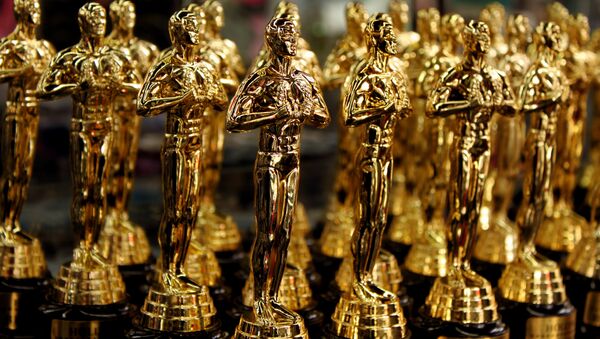The Oscars ceremony is traditionally presented by the Academy of Motion Picture Arts and Sciences (AMPAS), founded in Los Angeles in 1927 at the suggestion of Metro-Goldwyn-Mayer (MGM) chief Louis B. Mayer.
It was Douglas Fairbanks, the first president of AMPAS who proposed awards to recognize excellence in cinematic achievement. The first awards ceremony was held at a banquet at the Hollywood Roosevelt Hotel’s Blossom Room in Los Angeles on May 16, 1929.
The first winners were chosen in 12 categories for films released in 1927-1928. They were presented with the Academy Award of Merit, which was later nicknamed Oscar.
The first film to win the Best Picture award was William Wellman’s Wings. Special prizes were handed to Charlie Chaplin for The Circus and to the first sound film, The Jazz Singer. The first Best Actor awarded was Germany’s Emil Jannings and the first Best Actress award went to Janet Gaynor. All winners received honorary certificates commemorating their attendance at the first awards ceremony.
The winners had been announced to media three months earlier. That was changed for the second ceremony in 1930. For the rest of the first decade in Oscars’ history, the results were given to newspapers for publication at 11:00 pm on the night of the awards.
The Los Angeles Times put an end to this tradition when it divulged the winners’ names before the ceremony began. Since 1941, the Academy has used sealed envelopes to reveal the names of the winners.
In 1930, the Academy drew up a list of categories for merit that are now recognized as canon: Best Picture, Best Director, Best Actor in a Leading Role, Best Actress in a Leading Role, Best Writing, and Best Cinematography; an added category was Best Sound Mixing.
Awards for scientific and technological achievements were introduced later, such as the Best Visual Effects category in 1939.
In 1932, Best Animated Short Film and Best Live Action Short Film were added, followed by Best Actor in a Supporting Role and Best Actress in a Supporting Role. In 1941, the category of Best Documentary Short Subject was introduced.
In 1947, a foreign-language film was honored with the Special Achievement Award for the first time. In 1957, the Academy introduced the award for Best Foreign Language Film.
In 1948, Best Costume Design was added. In 1957, the Jean Hersholt Humanitarian Award was established. In 1964, Best Visual Effects was split into Best Visual Effects and Best Sound Editing. In 1982, a special Oscar for Best Makeup and Hairstyling was introduced, and in 2002, Best Animated Feature appeared.
In 1953, the first televised Oscar ceremony was broadcast to the United States and Canada. It has been aired in color since 1966 and went international in 1969. It is now broadcast in more than 200 countries.
The first winners were awarded an anonymous gilded statuette. According to one account, the Academy's Executive Secretary, Margaret Herrick, first saw the statuette in 1931 and said it reminded her of her Uncle Oscar (actually her cousin Oscar Pierce). The name was officially recognized in 1939.
The statuette was designed by MGM Executive Director Cedric Gibbons and sculptured by George Stanley. It is a stylized figure of a knight holding a sword. The knight stands on a reel of film with five spokes, which represent the original branches of the Academy: Actors, Writers, Directors, Producers, and Technicians.
The first statuettes were gold-plated solid bronze. Now they are made of gold-plated britannium on a black metal base. They are 13.5 inches tall and weigh 8.5 pounds.
Awards also include the Academy Honorary Award (given to celebrate motion picture achievements that are not covered by existing Academy Awards), the Jean Hersholt Humanitarian Award, the Irving G. Thalberg Memorial Award (to "creative producers, whose bodies of work reflect a consistently high quality of motion picture production"), the Academy Scientific and Technical Award, the Student Academy Award, among others.
Winners in these categories are chosen without nomination by a special committee and the awards are presented outside the main ceremony. Candidates are nominated by those related to the specific field in the industry.
Regular awards are presented for outstanding individual or collective film achievement in a wide variety of categories. Most categories (with the exception of Best Picture) are nominated by the members of the corresponding branch – actors nominate actors, film editors nominate film editors, etc.
All voting members are eligible to select the Best Picture nominees. Nomination voting is conducted via both paper and online ballots (introduced 2013). The Best Foreign Language Film is picked by an all-branch committee.
All eligible motion pictures must be feature-length movies (over 40 minutes), publicly exhibited by means of 35mm or 70mm film, or in a 24- or 48-frame progressive scan Digital Cinema format with a minimum projector resolution of 2048 by 1080 pixels, for paid admission in a commercial movie theater in Los Angeles County for a qualifying run of at least seven consecutive days.
There were several changes at the 82nd Academy Awards ceremony in 2010. For the first time there were ten, not five, nominees for Best Picture. Another change was that the nominated scores were presented as film clips rather than live music. All nominees were asked in advance to prepare two 45-second speeches. The show was hosted by two actors, rather than one as before.
Before 2004, the ceremonies were held in March; later they were shifted to the last Sunday in February.
Only three movies in history received a record 11 awards: Ben-Hur (1959), Titanic (1997), and The Lord of the Rings: The Return of the King (2003).
In 2015, Alejandro Gonzalez Inarritu’s Birdman won the Academy Award for Best Picture, along with Best Director, Best Original Screenplay, and Best Cinematography. Britain’s Edward Redmayne won the 2015 Oscar for Best Actor for playing physicist Stephen Hawking in The Theory of Everything. Julianne Moore grabbed the 2015 Best Actress for her performance in Still Alice.
J.K. Simmons was Best Supporting Actor winner for his part in Whiplash. Patricia Arquette was Best Supporting Actress winner for Boyhood.
Laura Poitras won the Academy Award for Best Documentary Feature for Citizenfour about Edward Snowden.
The Oscar for Best Visual Effects was awarded to Interstellar. French composer Alexandre Desplat was the Best Original Score winner (The Grand Budapest Hotel). Wes Anderson’s film was awarded for costumes, makeup, and direction.
Big Hero 6 won the Academy Award for Best Animated Feature. Ida directed by Poland’s Pawel Pawlikowski won the award for Best Foreign Language Film. Nominated in the same category was also The Leviathan directed by Russia’s Andrei Zvyagintsev.
In January 2016, the AMPAS Board of Governors voted unanimously to introduce a number of changes designed to diversify Academy membership, its governing bodies and election procedures. The aim is to double the number of women and minorities in the Academy by 2020.
The move was prompted by plans to boycott the Oscar ceremony announced by film director and actor Spike Lee, piqued by the absence of black nominees in the actor categories. Black actress Jada Pinkett Smith also promised to boycott the ceremony.
This year’s ceremony will be hosted by Chris Rock, an African-American multi-hyphenate artist, filmmaker and a well-known stand-up comic. He already hosted the Oscars in 2005.
This year, a nominee for Best Animated Short Film is We Can’t Live Without Space by Russian artist Konstantin Bronzit.



